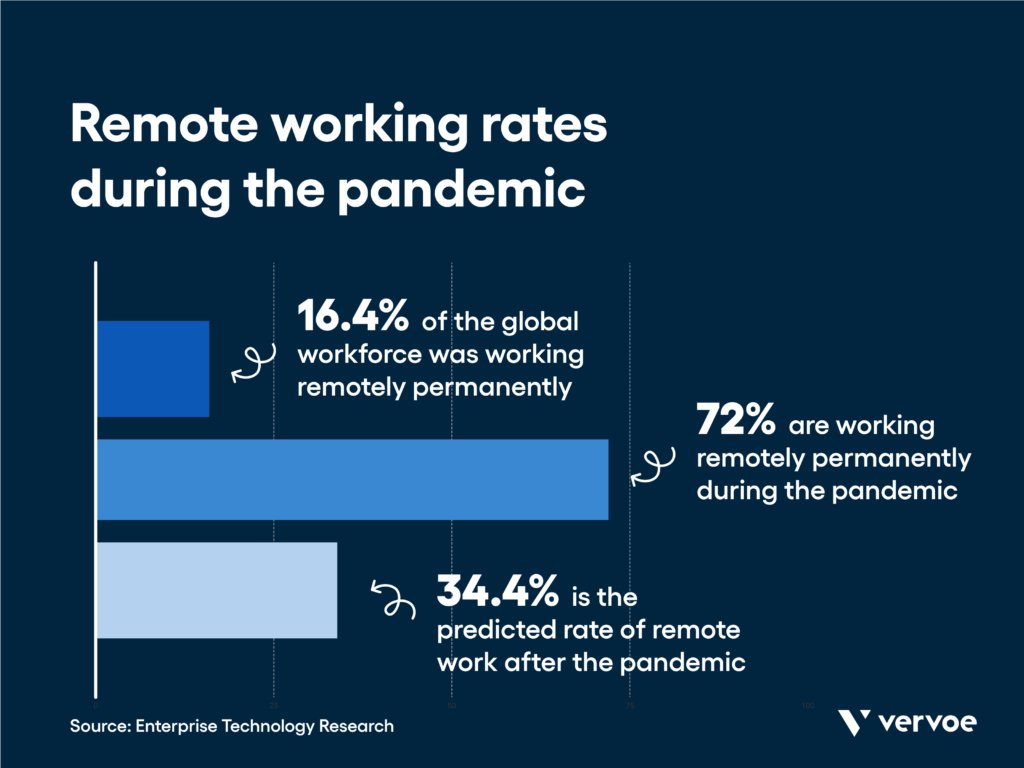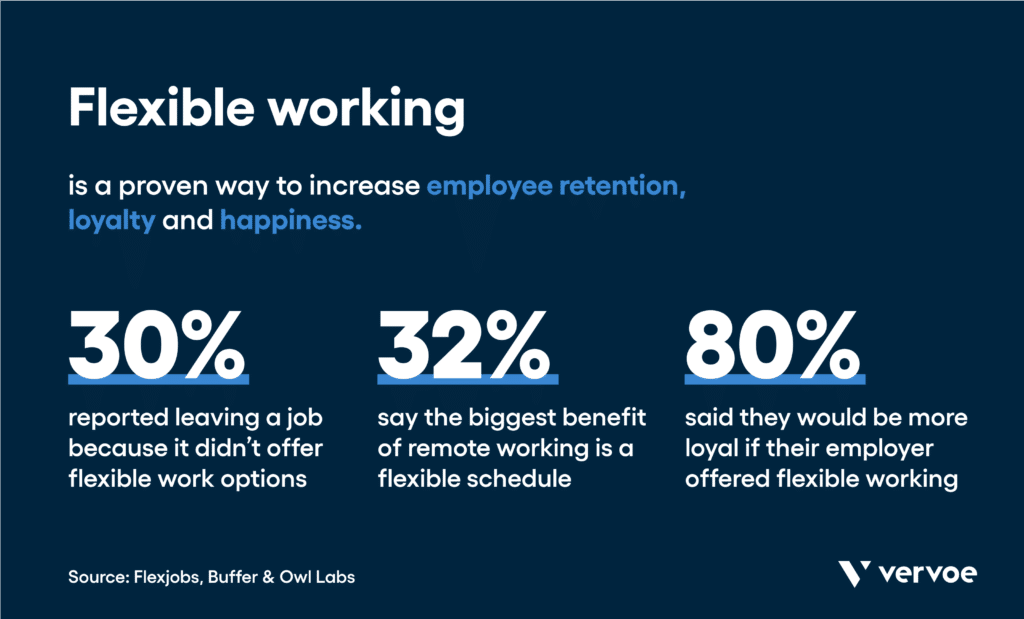COVID-19 is a trend accelerator. The crisis has turbocharged emerging trends in digital adoption to e-commerce and education to workplace flexibility. One of the most stunning accelerations has occurred with the rise of flexible work practices, including remote hiring. This list explores the key remote hiring statistics and trends for 2021.
Remote Hiring Trends
- Remote hiring is here to stay
- Remote workers are more productive
- Remote hiring increases retention
- Remote hiring decreases costs
- Remote hiring technology is booming
1. Remote hiring is here to stay
Remote working is extremely popular. While there will always be extroverts who say they need the “buzz” of the office, an incredible 97.6% of workers reported they would like to work remotely, at least some of the time, for the rest of their career. (Buffer)

Will the COVID-boosted boom in remote hiring continue after the pandemic? Several surveys have shown that leadership teams are generally willing to allow remote working to continue after the crisis.
- 82% of company leaders plan to allow employees to work remotely at least part of the time post-pandemic (Gartner)
- 80% of full-time workers expect to work from home at least three times per week (Owl Labs)
- 47% of leaders will allow employees to work from home full-time (Gartner)
- 74% of leaders intend to shift at least 5% of their on-site workforce to permanently remote positions (Gartner)
- 60% of workers believe a hybrid working model with a mix of remote and on-site work will be most productive going forward (Hays).
It’s unlikely, however, that remote working will continue at the peak rates experienced during the pandemic. The results of a global survey of CIOs make this clearer:
- Before the pandemic, 16.4% of the global workforce (in the IT sector) was working remotely permanently
- 72% are working remotely permanently during the pandemic
- Global CIOs expect permanent remote work to increase to 34.4% after the pandemic; double pre-pandemic levels but half of the pandemic peak (Enterprise Technology Research)

Something to be aware of is that the potential for permanent remote work is concentrated among highly educated, highly skilled workers in a handful of occupations in advanced economies. This can explain the frequently-cited statistic that remote workers are paid 8.3% more than office counterparts. (Payscale)
2. Remote workers are more productive
Why are so many employers keen to continue allowing remote working? Contrary to expectations, remote workers have increased productivity than their in-office colleagues.
- Three major studies (JD Edwards, American Express, and Compaq) found that remote workers are between 15% and 45% more productive than their office counterparts (Global Workplace Analytics)
- 75% of remote employees reported during the pandemic that they were able to maintain or improve productivity on individual tasks (BCG)
- 51% of remote workers maintained or improved productivity on collaborative tasks (BCG)
- 32% of remote workers were more engaged at work, compared to 28% of office workers (Gallup)
- Remote workers take only two to three weeks of paid leave per year, possibly due to lower stress. (Employment Hero)
3. Remote hiring increases retention
Depending on seniority, the cost of replacing an employee can range from 30% to 150% of their annual salary, making employee churn one of the most significant drains on a company’s finances (HHR).
The good news is that flexible working is a proven way to increase employee retention, loyalty, and happiness.
- 30% of respondents have reported leaving a job because it did not offer flexible work options (Flexjobs)
- 32% of respondents say the biggest benefit of remote working is a flexible schedule (Buffer)
- Half of those surveyed will not return to jobs that fail to offer remote work after COVID-19 (Owl Labs)
- 80% of people said they would be more loyal if their employer offered flexible work (Owl Labs)
- Remote workers scored higher on a Workforce Happiness Index than in-office colleagues (CNBC/Surveymonkey)

4. Remote hiring decreases costs
6 out of 10 employers identify cost savings as a significant benefit of remote work (Global Workplace Analytics). This is mainly in real estate costs (rent and utilities) and includes payroll costs as workers value flexibility over salary.
- IBM has saved $50 million per year in real estate costs, McKesson saved $2 million, and Sun Microsystems saved $68 million a year due to remote workers not needing office space. (Global Workplace Analytics)
- Other savings categories include cleaning services, parking spaces, food, and property tax.
- 47% of surveyed workers are willing to take a pay cut to work more hours from home (Platform.sh).
5. Remote hiring technology is booming
Consider how difficult it would have been to work from home or hire effectively during the pandemic if it had happened in the 1990s or early 2000s.
Luckily, companies in 2020 were able to leverage a rapidly maturing marketplace of tech solutions, including video conferencing for online interviews, collaboration software, employee onboarding, and other HR tools that enable remote hiring and improve the remote candidate experience. As expected, these markets are experiencing sharp growth that is expected to continue throughout the 2020s.
- The global video conferencing market size is predicted to grow from US$5.32 billion (2019) to US$10.92 billion (2027). Zoom’s annual revenue rocketed from US$623 million (January 2020) to US$2.65 billion (January 2021) (Fortune Business Insights)
- The global team collaboration software market will grow from US$13.44 billion (2019) to US$35.71 billion (2027) (Fortune Business Insights)
- Applicant Tracking Systems (ATS) will grow from US$1.08 billion (2017) to US$1.81 billion (2023) (Markets and Markets)
- The employee onboarding software market will grow from US$772.6 million (208) to US$2.19 billion (2027) (Absolute Market Insights).
Remote hiring is here to stay, which means that you need the right tools to hire great candidates, no matter where they’re located. Check out Vervoe For Remote Interviewing to learn more.




















